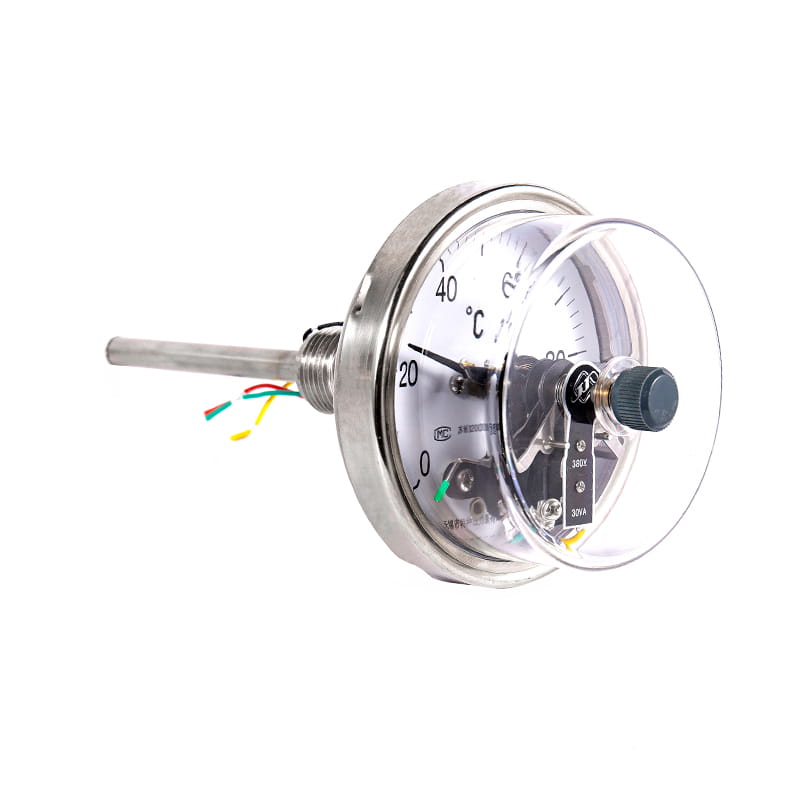YN series 100% copper connection earthquake-resistant (seismic) pressure gauge
Cat:Pressure Gauge
◆ Model: YN40 YN50 YN60 YN75 YN100 YN150◆ Use: This series of instruments have good shock resistance...
See DetailsTemperature monitoring is one of the most important process parameters in modern industry, chemical industry, electric power, HVAC, food processing and other fields. In order to meet the needs of accurate, durable and cost-effective temperature measurement, Bimetallic Thermometers came into being and stood out among many types of thermometers with its advantages such as no need for power supply, vibration resistance and intuitive reading.
1. What is Bimetallic Thermometer?
Bimetallic Thermometer, also known as bimetallic thermometer, is a mechanical temperature measurement device designed based on the principle of thermal expansion. It is mainly composed of two metal strips with different expansion coefficients (usually steel and copper or steel and aluminum) overlapped and welded into a spiral or helical shape. When the temperature changes, it expands and contracts to different degrees, driving the pointer to rotate, thereby displaying the temperature reading.
Because it does not require power support, has a simple structure and stable response, it is particularly suitable for on-site temperature indication under normal pressure or low pressure environment.
2. Working Principle Analysis
The core of the bimetallic thermometer lies in the bimetallic strip. It is composed of two metal materials with different thermal expansion coefficients. When the temperature rises, the metal with faster expansion pushes the whole piece to bend or rotate; by making it into a spiral or helical structure, this deformation can amplify the rotation angle and drive the pointer to rotate along the dial, thereby completing the temperature display.
Its overall composition includes:
Bimetallic temperature sensing element (core component)
Pointer and dial (temperature reading)
Protective sleeve (stainless steel or copper)
Connection method (thread, flange, clamp, etc.)
3. Product advantages and performance characteristics
No power supply required, easy operation
Mechanical design, no battery or external power supply, can work continuously, especially suitable for non-electrical environment or field measurement scenes.
Strong structure and good vibration resistance
It adopts metal shell and strong internal mechanism to adapt to mechanical vibration environment, such as pump room, fan unit and other equipment sites.
Stable response and intuitive reading
The real-time pointer indicates temperature changes, without waiting for the start time, suitable for applications that need to quickly judge the on-site working conditions.
Wide temperature measurement range
Common measurement range is from -50℃ to +500℃, and wider temperature range models can be customized to meet various working conditions.
Corrosion resistance and strong applicability
Using 304 or 316L stainless steel casing, it is suitable for corrosive environments such as oil, water, gas, weak acid and alkali.
Multiple installation methods are available
Optional radial, axial and universal structures, flexible installation, adapt to different equipment structures and viewing angles.
4. Typical application areas
Heating and air conditioning system (HVAC)
Used for temperature monitoring of boilers, water tanks, fan coils, cooling towers and other systems to ensure heating or cooling efficiency.
Petrochemical
Installed in pipelines, storage tanks, reactors, etc., real-time monitoring of medium temperature to ensure production process safety.
Mechanical equipment and power systems
Applied to surface temperature measurement of mechanical parts such as diesel engines, compressors, bearing seats, etc. to prevent overheating damage.
Food processing and pharmaceutical manufacturing
Real-time monitoring of the temperature of equipment such as mixing tanks, fermentation tanks, and liquid storage tanks to ensure product quality and sanitation safety.
Water treatment and environmental protection engineering
Used in heating pools, aeration tanks, water quality monitoring points, etc., to record the temperature change trend of liquids.
5. Selection recommendations and precautions
When purchasing a bimetallic thermometer, the following key factors should be considered comprehensively:
Temperature measurement range: Select the appropriate range according to the actual application requirements to avoid exceeding the upper limit of measurement.
Accuracy level: Common accuracy is ±1.0% or ±1.5%, and high-precision products can be selected under special requirements.
Installation method: Select radial, axial, universal and other pointer directions according to the on-site structure;
Insertion depth size: The depth of the probe inserted into the medium should be sufficient (it is recommended to be no less than 2 times the length of the temperature sensing element) to ensure accurate temperature measurement.
Material selection: For highly corrosive environments, stainless steel protective tubes should be selected and anti-corrosion seals should be selected.
Whether a thermal sleeve is required: It is recommended to use a protective sleeve in high-pressure or frequent disassembly and assembly environments to extend the life.
6. Development Trends and Future Directions
Although digital thermometers and sensors are becoming more and more popular, bimetallic thermometers will continue to be optimized in the following directions due to their advantages such as no need for power supply, strong anti-interference ability and low maintenance cost:
Integrated intelligent components: Combined with wireless communication modules to realize remote temperature reading collection;
Enhanced explosion-proof and anti-corrosion performance: used in special environments such as oil fields and chemical plant areas;
Miniaturization and improved aesthetics: suitable for temperature monitoring on household appliances or precision instruments;
Personalized customization services: Provide exclusive structure, color, and brand logo customization solutions according to the characteristics of the user's industry.
As a mature, practical and economical temperature measurement tool, Bimetallic Thermometers still play an important role in modern industrial and civil equipment. With its ruggedness, reliability, flexible installation and no need for power supply, it provides accurate temperature feedback and safety assurance for countless key process flows. In the context of intelligent manufacturing and industrial automation, bimetallic thermometers are evolving towards integration and multi-function, and will continue to occupy a place in many industries in the future. For users who pursue stability, durability and low maintenance costs, bimetallic thermometers are still a reliable choice for temperature monitoring.
